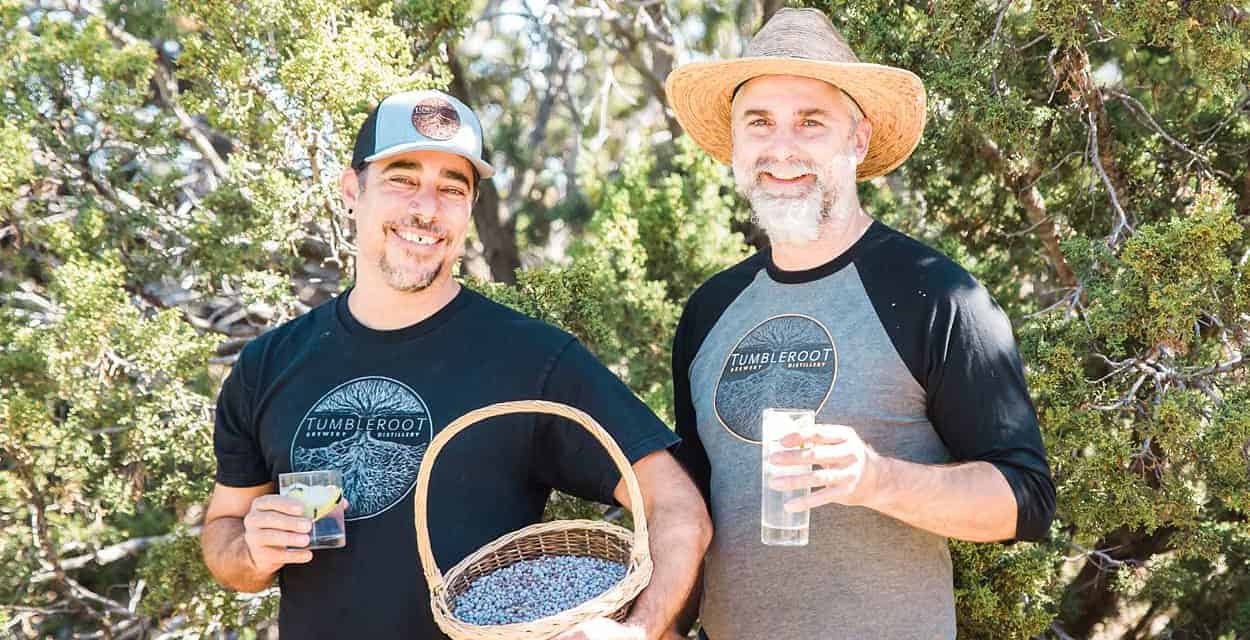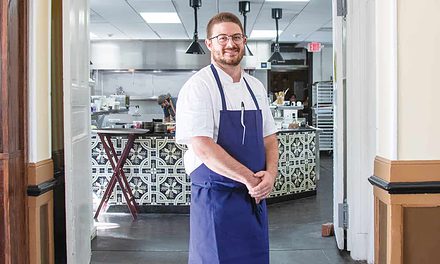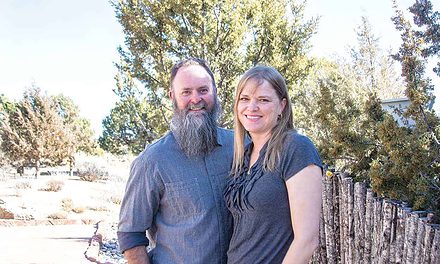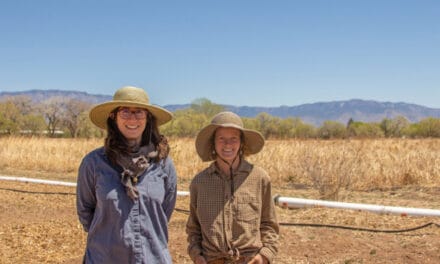An Interview with Jason Kirkman, Cofounder
Local Hero: Best Beverage Artisan, Spirits
Photos by Stacey M. Adams

Left to right: Michael Chavez, assistant brewer, and Jason Kirkman, cofounder of Tumbleroot Brewery and Distillery.
Jason Fitzpatrick and Jason Kirkman, cofounders, opened Tumbleroot in 2018. They had been developing the business, looking for a perfect space, and making some products during the two years prior. They wanted to open a community-oriented taproom that made all of its beer and spirits from scratch. Their main taproom is the old Club Alegria in Santa Fe, where they have hosted many musical acts and community events. Tumbleroot also self-distributes its beer and spirits throughout the state. Recently, they purchased a canning line and are canning three from-scratch cocktails. Next, Tumbleroot will be canning a Japanese-style rice lager and a hazy IPA, two beer styles that they love.
How did you get to where you are now? What’s the backstory, and what was the moment that brought you to your current work?
I was a biochemistry major, and I’ve always loved to cook. In college, I translated that passion and knowledge to homebrewing. My first job out of college was brewing at a small brewpub in the mid-1990s. I spent many years as a teacher, but continued to brew at home and follow changing brewing trends and techniques. When I decided to open my own place, I honed my chops by brewing at Bathtub Row Co-op up in Los Alamos and also did some work with Broken Trail in Albuquerque. I met my business partner, Jason Fitzpatrick, at Bathtub Row. He was their first general manager and also had experience at Marble Brewery. We were a good team, so we decided to build Tumbleroot together.
How has travel influenced your brewing and distilling and the ethos behind it?
Travel has been a significant influence on my life and in my practice and sensibilities as a brewer and distiller. My family and I took a two-year trip around the world where we focused on learning regional specialties and cooking with the people we met. We did try many different brews, wines, and spirits, but learning about the ways that folks from around the world use different ingredients to achieve different flavor profiles was probably the thing that has most influenced my craft.

Left to right: Tumbleroot’s Botanical Gin; Angela Kirkman foraging juniper berries; wild-harvested juniper berries.
Among distillers, organic and local sourcing are still fairly rare. What has influenced your decisions to use organic and local ingredients?
We only use organic ingredients in our distillation process. These ingredients are generally higher quality and are more environmentally sustainable, which is one of our core principals. The fact that distillation tends to concentrate certain compounds makes me feel that these ingredients are potentially much safer.
Local sourcing is extremely important to us. We try to grow as many connections with local businesses as possible. We love Santa Fe and want to see it flourish. And we use seasonal, garden-grown, and wild-harvested ingredients to make our products distinctive of this place.
More than other spirits, gin seems to involve a bit of alchemy. How do you achieve the perfect floral balance? What is quintessential to a London dry?
We have changed the name of our London dry gin to High Desert Gin. It was just too different from most London drys, though it and our Botanical Gin have become our most popular spirits.
We actually began the process of developing our gins by doing single ingredient distillations, then blending to come up with the flavor profiles we were searching for. Those are really fun experiments. The Botanical Gin is very floral, and the High Desert Gin was inspired by a Thai pomelo salad. We also make a Navy Strength Gin which uses a lot of warm spices and spends some time in a barrel.
You don’t filter your vodkas. Why not?
Our main vodka is a sugarcane vodka. We buy organic evaporated cane juice and ferment with a rum yeast in-house, then distill it to above 190 proof. It is very clean and very smooth, and the flavors are subtle, but we don’t want to eliminate or diminish (through filtration) the distinctive flavors that come from the sugarcane and the fermentation. I’ve heard it described as crème brûlée: caramel and banana. But it is a vodka, and those flavors are subtle.
How much hand sanitizer have you produced this year? What else has changed in response to the pandemic? How have you fared?
We’ve produced over five thousand gallons of hand sanitizer. Since our prices are pretty competitive and we’ve established a lot of relationships with local organizations, we still continue to produce and sell, though the demand has shrunk quite a bit in the past couple of months. Since our taprooms were closed, we threw all of our energy into packaging and distribution. We purchased a small counter pressure canning line and have been making a lot of canned cocktails in response to the demand. Our patio opened a month ago. People have told us that we have the best anti-COVID practices they have seen, which feels good. And it’s a comfortable and purpose-built patio space, which we are lucky to have. We are hanging in there.
What cocktail will you be drinking this holiday season?
A negroni made with our Navy Strength Gin.
32 Bisbee Court and 2797 Agua Fria, Santa Fe,
tumblerootbreweryanddistillery.com
Edible celebrates New Mexico's food culture, season by season. We believe that knowing where our food comes from is a powerful thing. With our high-quality, aesthetically pleasing and informative publication, we inspire readers to support and celebrate the growers, producers, chefs, beverage and food artisans, and other food professionals in our community.

















